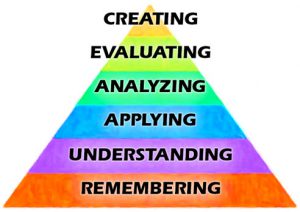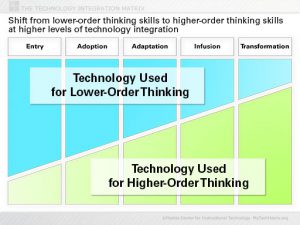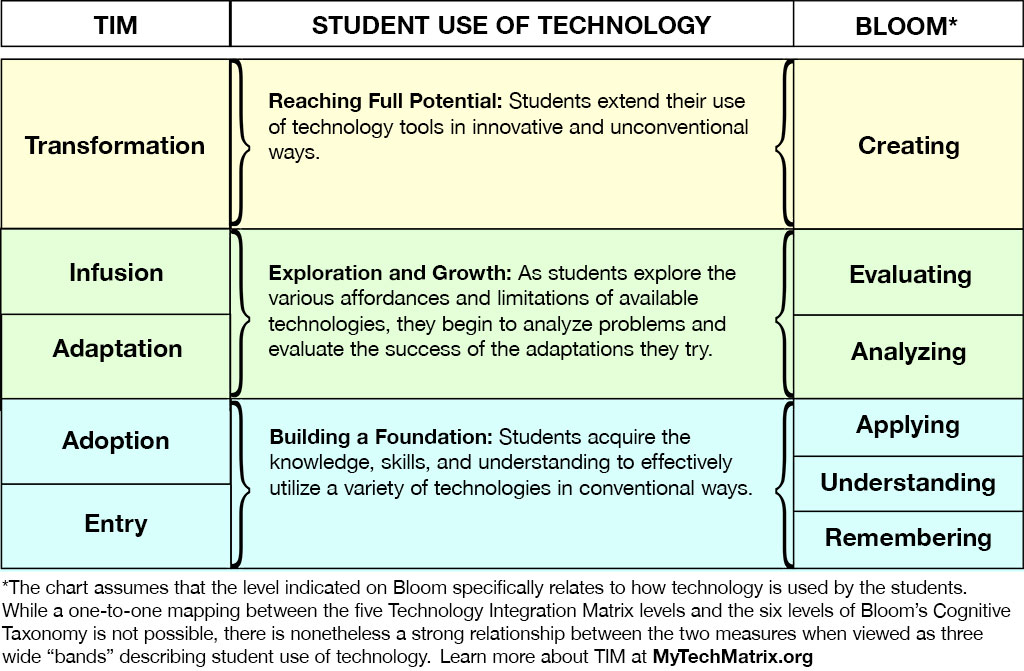 Bloom’s Cognitive Taxonomy is familiar to nearly every educator. The illustration at left shows the six categories of Anderson and Krathwohl’s 2001 revision of Bloom’s Taxonomy: remembering, understanding, applying, analyzing, evaluating, and creating.
Bloom’s Cognitive Taxonomy is familiar to nearly every educator. The illustration at left shows the six categories of Anderson and Krathwohl’s 2001 revision of Bloom’s Taxonomy: remembering, understanding, applying, analyzing, evaluating, and creating.
When talking with school leaders who are new to the TIM or who are considering licensing TIM Tools, we are often asked how the TIM compares with other models they are familiar with. A common question is whether the five levels of the Technology Integration Matrix can be mapped to the six levels of Bloom’s Cognitive Taxonomy. But before I answer that, it’s important to review what the two models actually are.
Bloom is a model of thinking skills from lower-order skills such as simple remembering to higher-order thinking skills (HOTS) such as evaluating or creating. Although its original purpose was to avoid redundant efforts in test development, it is more generally used by teachers to inform the development of learning activities.
TIM is a model of technology use from entry-level activities up through transformation-level use. Its purpose is to help teachers more effectively integrate available technology into their lessons by aligning its use to five characteristics of effective learning environments: active, collaborative, constructive, authentic, and goal directed learning.
 Last month when discussing the relationship between the ISTE Standards and the TIM, I suggested that the Technology Integration Matrix can be considered as an implementation framework for the ISTE Standards. The same can be said of the relationship between the TIM and Bloom. Using the TIM to design or modify lessons helps ensure that technology use increasingly supports higher-order thinking skills. One of the underlying principles behind the Matrix is that higher levels of technology integration on the TIM require higher-order thinking on the part of the students as summarized in the adjoining chart.
Last month when discussing the relationship between the ISTE Standards and the TIM, I suggested that the Technology Integration Matrix can be considered as an implementation framework for the ISTE Standards. The same can be said of the relationship between the TIM and Bloom. Using the TIM to design or modify lessons helps ensure that technology use increasingly supports higher-order thinking skills. One of the underlying principles behind the Matrix is that higher levels of technology integration on the TIM require higher-order thinking on the part of the students as summarized in the adjoining chart.
Any lesson at the “top” of the TIM is going to be at the “top” of Bloom simply because the descriptors for Transformational level lessons include innovation (i.e. creating) on the part of the students. The reverse is not necessarily true. One can imagine a class discussion that included no use of technology, but required critical thinking on the part of the students. Effective teachers engaged their students with higher-order thinking tasks long before the advent of the personal computer.
However, if you think about the Bloom levels within the context of student use of technology, a general relationship between the TIM and Bloom becomes apparent. Using technology to create is an essential component at the Transformational level of the TIM. In lessons at the Adaptation and Infusion levels, students analyze and evaluate. And at the Entry and Adoption levels, students exercise lower-order thinking skills as they learn how to use technology in conventional ways. The three broad bands of agreement between the two models can be seen in the following graphic.
The TIM supports, but in no way supplants Bloom’s Cognitive Taxonomy. Adopting the TIM as an aid in lesson planning and classroom observation will help a school or district better utilize their existing technology to meet the goal of developing higher-order thinking skills in their students.
Roy Winkelman is a 40+ year veteran teacher of students from every level kindergarten through graduate school. As the former Director of FCIT, he began the Center's focus on providing students with rich content collections from which to build their understanding. When not glued to his keyboard, Dr. Winkelman can usually be found puttering around his tomato garden in Pittsburgh.

